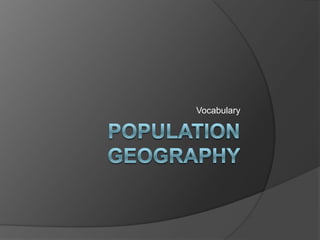
Population geography vocabulary
- 1. Vocabulary
- 3. Population Vocabulary Demography Population Pyramid Population Replacement Rate Distribution Dependency Ratio Population Density Birth Rate Death Rate Life Expectancy Demographic Transition Model 3
- 4. Demography The study of human populations and how they change over time. Vocabulary 4
- 5. Population Distribution The pattern of population- where people live- in a country, a continent, or the world. Looking at the map, how can you tell where the largest populations live in the United States? Can you describe where the largest population distribution is in the U.S.? What about the lowest Vocabulary population distribution? 5
- 6. Population Distribution Sparsely populated- contain few people Tend to be difficult places to live Example: Antarctica Densely populated- contain many people Tend to be livable environments Example: Europe 6
- 7. Where do people live in the U.S.? What do the bright lights indicate? Why are there more bright lights on the east coast? What influences where people live in the United States? Describe which areas are sparsely populated and which are densely populated. 7
- 8. Population Density Average number of people who live in a measurable area such as a square mile or kilometer. What do you notice about the population distribution of the world? What areas have a high population density? What areas have a low population density? Vocabulary Internet Geography 8
- 9. Population Density Notice that the world’s population is uneven. The most densely populated areas are located between 20°N and 60°N. This area has a large amount of land with temperate temperatures. 9
- 10. Factors Affecting Population Density Physical High Density Low Density Factors Shape and height Low land which is flat. High land that is of land Ex. Northern European mountainous. Ex. Plain Himalayas Resources Areas rich in Areas with too few resources (coal, oil, resources. Ex. Area wood, fishing, etc.) Ex. located below Sahara Western Europe called The Sahel Climate Areas of temperate Areas with extreme climates- plenty of rain hot and cold climates. and heat. Ex. The Ex. Sahara United Kingdom 10
- 11. Factors Affecting Population Density Human High Density Low Density Factors Political Countries with stable Countries with governments. Ex. unstable United States governments- people migrate. Ex. Afghanistan Social People want to live People prefer to be close to each other for isolated. Ex. security. Ex. United Scandinavians States Economic Good job opportunities Limited job particularly in large opportunities. Ex. cities. Amazon Rainforest 11
- 12. Factors for population changes Birth rate Death rate Migration The first two factors are the major reasons for the change. When birth rates are higher than death rates, the population will increase. 12
- 13. Birth Rate The number of births in a year for every 1,000 people in a population. What regions have lower birth rates? What regions have higher birth rates? Why do regions in the world have different levels of birth rates? Vocabulary The darker colors represent the countries with high birth rates 13
- 14. Death Rate The number of deaths in a year for every 1,000 people in a population. What regions have low death rates? What regions have high death rates? Why do different regions of the world have higher death rates? Vocabulary The darker colors represent the countries with higher death rates. 14
- 15. Life Expectancy The number of years a person can expect to live. Japan has highest life expectancy in the world. Vocabulary 15
- 16. Life Expectancy Life expectancy gives an overall indicator of how healthy a country is. A great deal of information can be derived from studying life expectancy such as the standard of living. As a general rule, the higher the life expectancy, the healthier (and more developed) a country is. 16
- 17. Demographic Transition Model The model shows how a countries population Vocabulary changes as it develops. The model is divided into 4 stages. Internet Geography 17
- 18. Demographic Transition Model Stage 1 Low population growth Birth & death rates high- results in little population change Characterized world population until 17th century Low total population 18
- 19. Demographic Transition Model Stage 2 Rapid population growth Birth rate is high with economic development beginning Death rate falls with improved healthcare and more food 19
- 20. Demographic Transition Model Stage 3 Population growth begins to slow Falling birth rate- as economy improves growth slows Low death rate 20
- 21. Demographic Transition Model Stage 4 Negative or no population growth Birth and death rates drop to low levels Over time birth rates fall behind death rates High total population 21
- 22. Population Pyramid A graph that is used to show the males and females within different age groups of a population. Vocabulary 22
- 23. The female population from 20-24 years would make up a little over 4% of the population. 23
- 24. 24
- 25. Population Pyramids Wide at bottom shows rapid population growth- more born than dieing Straight sides show nearly equal Narrow at bottom shows negative population growth- more dieing than born 25
- 26. Population Pyramids Developing countries usually have wide base and narrow top- represents high birth & death rates Developed countries usually have equal distribution through age groups- top gets narrower due to deaths 26
- 27. Replacement Rate When enough babies are born to replace those people who die each year. Vocabulary 27
- 28. Dependency Ratio Compares the number of dependents too young or old to work (persons under age 15 or above age 64) with the countries working-age population (persons over ages 15 to 64). Vocabulary 28
- 29. Dependency Ratio Low dependency- too few workers have few dependents to support High dependency- a high means a lot of young or old people for workers to support 29